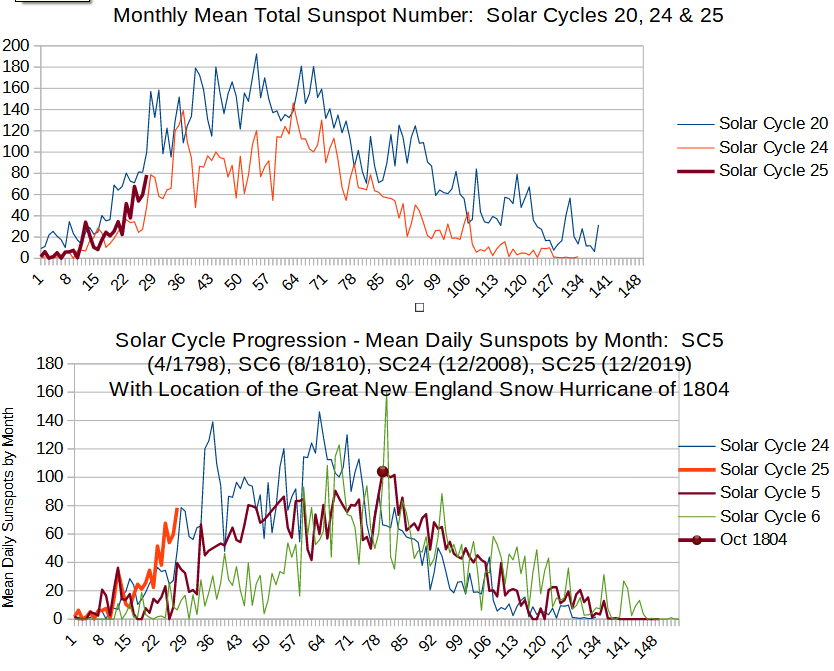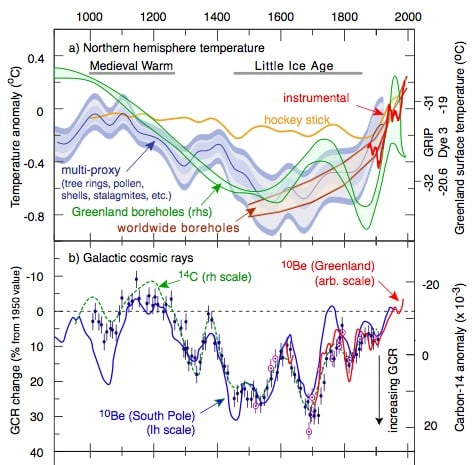|
|
Post by flearider on Apr 1, 2022 20:34:36 GMT
Recent Solar Cycle Progressions Versus the 1960s and the Dalton Minimum.  my bet is it will peek early and dropout sooner ... the last gasp ...  |
|
|
|
Post by missouriboy on Apr 1, 2022 20:55:51 GMT
I need to find a nice, warm coral reef.
|
|
|
|
Post by nonentropic on Apr 1, 2022 23:24:09 GMT
So shaping towards a low medium which is what 24 was.
Should in of its self be interesting. Does the solar cycle influence the AMO trajectory.
|
|
|
|
Post by missouriboy on Apr 2, 2022 5:52:49 GMT
So shaping towards a low medium which is what 24 was. Should in of its self be interesting. Does the solar cycle influence the AMO trajectory. My guess is that the solar cycles affects the amount of energy absorbed by the oceans, which are then pushed around by other forces such as lunar tidal pulses. A cooler ocean still has Ninos and Ninas with less heat in the form of water vapor driving the atmosphere. |
|
|
|
Post by Jane in the centre of England on Apr 10, 2022 9:54:44 GMT
A question from a non-specialist. Spaceweather.com says solar cycle 25 is kicking in, more strongly than SC24. With increased sunspot activity, the stream of solar wind gets stronger, correct? And that keeps cosmic rays out of the solar system, correct? So my question is, why are cosmic rays still so high? cosmicrays.oulu.fi/ says they are still at a historic high (although they have declined slightly this year). Is it that the sunspots are greater in number but too weak in intensity to keep the cosmic rays out? |
|
|
|
Post by missouriboy on Apr 10, 2022 14:48:14 GMT
A question from a non-specialist. Spaceweather.com says solar cycle 25 is kicking in, more strongly than SC24. With increased sunspot activity, the stream of solar wind gets stronger, correct? And that keeps cosmic rays out of the solar system, correct? So my question is, why are cosmic rays still so high? cosmicrays.oulu.fi/ says they are still at a historic high (although they have declined slightly this year). Is it that the sunspots are greater in number but too weak in intensity to keep the cosmic rays out? Welcome Jane. Hope that your spring is coming along nicely. Ours is intermittently retarded.  That is a very good question, and as yet publicly unanswered. The desk-bound scientificrats are jousting at windmills. So far, sunspots seem to be moving along a trajectory reasonably close to SC24, and below SC20. Theoretically, cosmic rays should follow past trends. If not, that would be an important scientific moment. As interesting would be how UV radiation is changing. Can't find an acceptable database. The following chart (I suspect a Swenmark source based on filename) shows the inverse relationship of cosmic rays and earth temperatures, which should be directly related to solar outputs. I encourage you to search out past works and report back to us. All of us would be very interested. You are just as qualified to observe and question as "they" are. Tallyho.
 |
|
|
|
Post by ratty on Apr 11, 2022 7:17:04 GMT
|
|
|
|
Post by Jane in the centre of England on Apr 11, 2022 8:03:27 GMT
A question from a non-specialist. Spaceweather.com says solar cycle 25 is kicking in, more strongly than SC24. With increased sunspot activity, the stream of solar wind gets stronger, correct? And that keeps cosmic rays out of the solar system, correct? So my question is, why are cosmic rays still so high? cosmicrays.oulu.fi/ says they are still at a historic high (although they have declined slightly this year). Is it that the sunspots are greater in number but too weak in intensity to keep the cosmic rays out? Welcome Jane. Hope that your spring is coming along nicely. Ours is intermittently retarded.  That is a very good question, and as yet publicly unanswered. The desk-bound scientificrats are jousting at windmills. So far, sunspots seem to be moving along a trajectory reasonably close to SC24, and below SC20. Theoretically, cosmic rays should follow past trends. If not, that would be an important scientific moment. As interesting would be how UV radiation is changing. Can't find an acceptable database. The following chart (I suspect a Swenmark source based on filename) shows the inverse relationship of cosmic rays and earth temperatures, which should be directly related to solar outputs. I encourage you to search out past works and report back to us. All of us would be very interested. You are just as qualified to observe and question as "they" are. Tallyho.  Thank you for that, missouriboy. I wondered if I was missing something. Why do you mention UV radiation trends?. Spring is swinging into action here in central England, after a brief return to winter last week with night frosts. The snowdrops, crocuses and daffodils are finished and now the primroses are here and the tulips are appearing. Daytime temperatures back into double figures. |
|
Astromet
Level 3 Rank
   Meanwhile, here in the real world...
Meanwhile, here in the real world...
Posts: 168
|
Post by Astromet on Apr 11, 2022 8:09:48 GMT
Well, let's not dismiss the Wuhan Lab at all Ratty, however, the relationship between what is happening in space and the spread of virus, along with the conductivity of the Earth's atmosphere, the weather and climate has been something I have warned about for years. The effect of the solar magnetic field decreases during the minimum sunspot, and the cosmic ray enters the atmosphere with high-energy particles from external and extragalactic sources" is what I warned about years ago, including on solar cycle#24 board. Here's just one of the pieces on high-energy cosmic rays penetrating into our solar system ->> solarcycle24com.proboards.com/thread/2612/forecast-winter-prelude-global-cooling |
|
|
|
Post by Jane in the centre of England on Apr 11, 2022 8:18:29 GMT
 Here is the graph of cosmic rays from 1964. Even though it has dipped slightly, it is still at or above the level it reached at any of the previous solar minima since then. From cosmicrays.oulu.fi/
It is as if there is a new base platform, or something has shifted since the start of SC24.
PS Sorry for the small image. Not sure how to enlarge it. |
|
|
|
Post by blustnmtn on Apr 11, 2022 13:07:03 GMT
<button disabled="" class="c-attachment-insert--linked o-btn--sm">Attachment Deleted</button>Here is the graph of cosmic rays from 1964. Even though it has dipped slightly, it is still at or above the level it reached at any of the previous solar minima since then. From cosmicrays.oulu.fi/
It is as if there is a new base platform, or something has shifted since the start of SC24.
PS Sorry for the small image. Not sure how to enlarge it. Welcome to the forum Jane! I'm no expert on the subject but I believe it is widely accepted that the Earth's magnetic field has been consistently weakening over the last century and continues as well as wondering. Since it is a large factor responsible for shielding the Earth from cosmic rays, it makes sense that there should be an inverse relationship between magnetic field strength and surface cosmic ray detection. Some good info: climate.nasa.gov/news/3105/earths-magnetosphere-protecting-our-planet-from-harmful-space-energy/ |
|
|
|
Post by Jane in the centre of England on Apr 11, 2022 14:23:42 GMT
<button disabled="" class="c-attachment-insert--linked o-btn--sm">Attachment Deleted</button>Here is the graph of cosmic rays from 1964. Even though it has dipped slightly, it is still at or above the level it reached at any of the previous solar minima since then. From cosmicrays.oulu.fi/
It is as if there is a new base platform, or something has shifted since the start of SC24.
PS Sorry for the small image. Not sure how to enlarge it. Welcome to the forum Jane! I'm no expert on the subject but I believe it is widely accepted that the Earth's magnetic field has been consistently weakening over the last century and continues as well as wondering. Since it is a large factor responsible for shielding the Earth from cosmic rays, it makes sense that there should be an inverse relationship between magnetic field strength and surface cosmic ray detection. Some good info: climate.nasa.gov/news/3105/earths-magnetosphere-protecting-our-planet-from-harmful-space-energy/Thank you for the welcome. Good point about the earth's magnetic field. It has certainly been behaving strangely - with the north geomagnetic pole galloping towards Siberia from Canada for example. I'm sure that's an ingredient. I don't remember reading anywhere that it went through a sudden decline in the last decade, which is the date from which cosmic rays have stayed consistently high. I'll check it out, though. |
|
|
|
Post by blustnmtn on Apr 11, 2022 14:34:58 GMT
Welcome to the forum Jane! I'm no expert on the subject but I believe it is widely accepted that the Earth's magnetic field has been consistently weakening over the last century and continues as well as wondering. Since it is a large factor responsible for shielding the Earth from cosmic rays, it makes sense that there should be an inverse relationship between magnetic field strength and surface cosmic ray detection. Some good info: climate.nasa.gov/news/3105/earths-magnetosphere-protecting-our-planet-from-harmful-space-energy/Thank you for the welcome. Good point about the earth's magnetic field. It has certainly been behaving strangely - with the north geomagnetic pole galloping towards Siberia from Canada for example. I'm sure that's an ingredient. I don't remember reading anywhere that it went through a sudden decline in the last decade, which is the date from which cosmic rays have stayed consistently high. I'll check it out, though. Cosmic ray intensity on Earth also increases with lower sunspot numbers. It peaks at solar minimum. Since SC24 was quite weak, it should have caused an increase compared to SC23. |
|
|
|
Post by Jane in the centre of England on Apr 11, 2022 14:47:44 GMT
Cosmic ray intensity on Earth also increases with lower sunspot numbers. It peaks at solar minimum. Since SC24 was quite weak, it should have caused an increase compared to SC23. Yes, that makes sense. So, the combination of a weakening geomagnetic field and weak SC24 leads to a new high of cosmic rays reaching Earth. Which says that SC25 isn't exactly packing a punch yet. |
|
|
|
Post by ratty on Apr 11, 2022 15:51:54 GMT
<button disabled="" class="c-attachment-insert--linked o-btn--sm">Attachment Deleted</button>Here is the graph of cosmic rays from 1964. Even though it has dipped slightly, it is still at or above the level it reached at any of the previous solar minima since then. From cosmicrays.oulu.fi/It is as if there is a new base platform, or something has shifted since the start of SC24.
PS Sorry for the small image. Not sure how to enlarge it. Jane, wrt the small image, you appear to have have used the 'Attachment' button instead of the 'Insert Image' (  ) button. If I use the 'Insert Image' button, this is the result (taking a right-click 'Copy image address' reference from cosmicrays.oulu.fi/): |
|